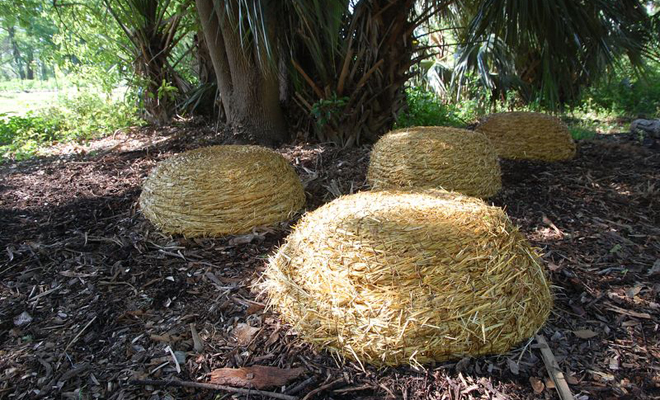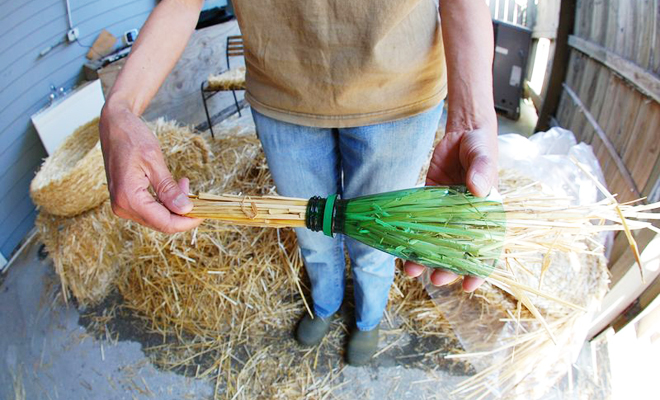Fungus Amongus: Mei-ling Hom, David McClelland, and Living Sculpture

The corona of oyster mushrooms emerges from the coiled straw sculptures by Mei-ling Hom and David McClelland.
Editor's Note
While participating in the Joan Mitchell Center’s Artist-in-Residence Pilot Program in New Orleans, husband-and-wife artists and farmers Mei-ling Hom and David McClelland created a living sculpture project. Now back in their part-time home of Andover, New York, McClelland reflects on the process.
Imagine the surface of the earth as a thin film separating the swirling atmosphere from lightless depths. It is easy to see water vapor forming billowing clouds in the sky and equally easy to see the clouds made up of quadrillions of algae blooming in the sea. But the clouds under the earth’s surface, formed by the ever-growing mycelia (roots) of fungi, only come to our attention when they thrust forth their fruiting bodies (mushrooms) into the open air.
In an attempt to make the invisible apparent, we embarked on a project in New Orleans earlier this year, transforming straw sculptures into mushrooms at the Grow Dat Youth Farm in City Park. Mei-ling and I usually divide our lives between twin interests as artists and farmers, alternating between an urban studio in Philadelphia and an 85-acre farm high in the hills of western New York state. So it was natural to combine the visual, the palpable, and the edible to create sculptures that have a life first as artworks and then transform into soil with a delicious harvest of mushrooms to mark their passing.
As a continuation of her cloud sculptures constructed in stainless steel, marble, wood, and clay over the last several years, Mei-ling envisioned a grouping of living clouds made from mushrooms. The first set, made in Abington, Pennsylvania in 2011, were formed of Agaricus (the familiar white button mushroom) spawn packed into wire armatures cased with peat moss, resulting in fuzzy spheres with bursts of mushrooms popping out all over as they matured. This was followed by a semi-permanent installation of poplar trunks and branches inoculated with Pleurotus (oyster mushroom) spawn and arranged on the wooded grounds of the Abington Art Center near Philadelphia to send forth their fruiting bodies and gradually decay into the humus layer of the forest floor.
While working on our farm in Andover, New York, surrounded by vegetables and grain fields, Mei-ling was inspired by the ancient forms of bee skeps—coiled straw forms for housing bee colonies. She envisioned similarly coiled straw sculptures, which would be packed with materials for the oyster mushrooms to colonize and consume, creating a valuable soil amendment in the process and a corona of elegant edible mushrooms. The first of these straw sculptures traveled in 2012 to the Contemporary Art Center in Cincinnati, where it had to remain dry so that the mushrooms wouldn’t grow and threaten the other works of art in the museum. So when our residency at the Joan Mitchell Center in New Orleans presented us with the opportunity to work within a sylvan glade at Grow Dat Youth Farm, we eagerly launched into our experiment combining aesthetics and agriculture, devoting several weeks to crafting straw ropes and sewing them into three- dimensional forms.

The coiled straw sculptures are packed with materials for the oyster mushrooms to colonize and consume.
Local mushroom grower James Shoop provided bags of healthy and beautiful oyster mushroom spawn, which we combined with straw filling sterilized in vast galvanized tubs over propane burners like some vegetarian crawfish boil. Boiling the wheat straw created a dark sticky broth with a slightly sweet odor, which competed with the blooming tropical scents of New Orleans in April. After draining and cooling, the sterilized straw was combined with the mushroom spawn and packed into the forms sewn from the straw ropes. Everything involved in the sculptures—straw, spawn, and sisal twine—was picked because it is biodegradable. After the visual life of the sculpture is finished, no art historian of the future will be picking fragments out of the ruins and puzzling out a meaning.
The project culminated in a workshop held beside the growing fields along the bayou at Grow Dat. A diverse crowd of gardeners, artists, and even some curious passers-by joined us to learn the basics of straw work and mushroom inoculation. In one of those wonderful moments of serendipity, Mr. Jung, a retired agricultural scientist from Sellersville, Pennsylvania who was visiting his daughter in New Orleans, stopped to watch the activity. Within minutes he devised and taught us a vastly superior method of plaiting and rolling the straw to form long durable ropes. Maybe the snack table filled with delectable mushroom puff pastries from the artist bakers at Shake Sugary had a hand in attracting the crowd.
Our final intervention in the natural order was to provide a heartbeat drumming session led by master percussionist Luther Gray. The pristine straw domes were just showing the feathery white mycelia (roots) of the oyster mushrooms on their undersides when we left New Orleans in a drenching subtropical storm. Drumbeats and rain proved a potent combination because an excited email caught us on the road home showing an opulent crown of fruiting mushrooms bursting from the straw sculptures. Now as summer comes to a close, the sylvan border that inspired the work’s original placement has undergone its own natural transformation, and what is left of the works has been relocated under a tree nearby. No mushrooms are visible as the straw sculptures slump, fall apart, and gently fade into the soil beneath.

Artist Mei-ling Hom demonstrates a method for organizing the straw using a severed bottle.



